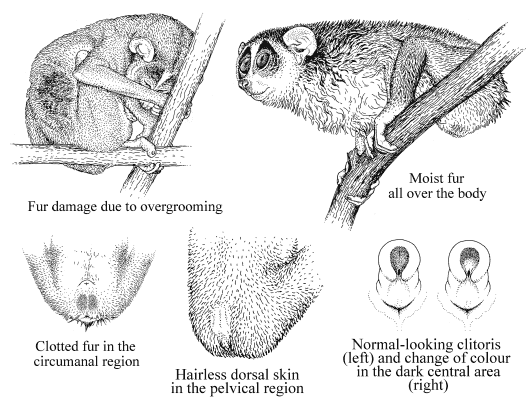
| Home |
|
|
|
Symptoms of health
problems:
changes
of fur and skin in Loris indicating problems

In
healthy slender
lorises, the fur looks dense and velvety. Fatty or wavy
appearance of hair,
particularly on the thighs, is observed in older animals, in
cases of decreasing
health, after grooming of the fur or as a peculiarity of certain
individuals
(one small reddish specimen bred from stock from Sri Lanka for
instance
shows a wavy fur of silk-like, shining appearance on legs and
trunk). Animals
with a higher age and decreasing health may show an irregular
hair length.
Grey patches on the sides of the trunk, showing the colour of
underwool
because of missing superficial hair, is apparently caused by
excessive
grooming of the fur, a behavioural disturbance. This behaviour
was, in
few cases, observed in nervous animals housed together with
strong, self-confident
conspecifics or in a male constantly rejected by an elderly, no
longer
receptive female. Overgrooming seems to indicate social stress
although
no quarreling was observed in such cases. When the animals were
separated,
fur became normal again. Moist fur all over the body was
observed in several
animals during an intestinal infection with protozoa (the
animals were
vivid and showed no other signs of unwellbeing) and in a female
during
an unsuccessful stillbirth (the baby had died before birth and
had to be
removed by the veterinarian. Clotted fur in the hind tip of
trunk, close
to the anus, seems to indicate diarrhoea-like problems. Soft,
diarrhoeic
faeces were not observed in this context. A naked patch of skin
may occur
in the region of trunk which is in contact with the branch
during sleeping
period. In such cases, replacing or more frequent cleaning of
the branches
ought to be considered; the layer of urine covering the branches
may in
the long run irritate the skin and lead to inflammation. In a
female with
an infection of the bladder, the usually dark area on the tip of
the clitoris
turned to a pinkish colour in the proximity of the urethral
opening. Comparable
slight changes were occasionally seen in old animals showing
signs of diabetes.
It is not yet clear whether this change is a reliable sign for
diagnosis
of infection of the urinary tract.
|
Loris
and related species: health
|
Last
amendment: 5 May 2000
|